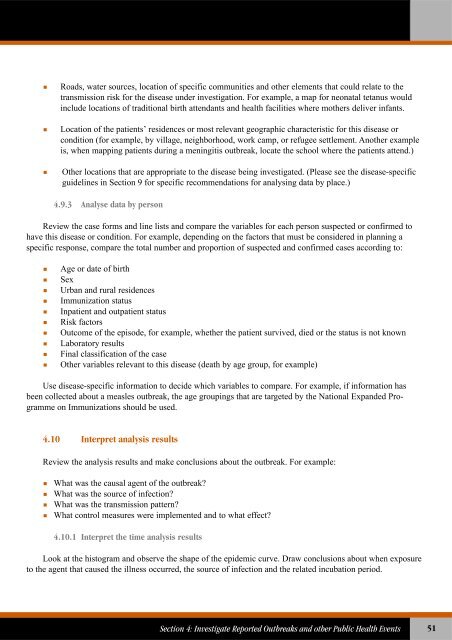Technical Guidelines for Integrated Disease Surveillance ... - PHRplus
Technical Guidelines for Integrated Disease Surveillance ... - PHRplus
Technical Guidelines for Integrated Disease Surveillance ... - PHRplus
You also want an ePaper? Increase the reach of your titles
YUMPU automatically turns print PDFs into web optimized ePapers that Google loves.
Roads, water sources, location of specific communities and other elements that could relate to thetransmission risk <strong>for</strong> the disease under investigation. For example, a map <strong>for</strong> neonatal tetanus wouldinclude locations of traditional birth attendants and health facilities where mothers deliver infants.Location of the patients’ residences or most relevant geographic characteristic <strong>for</strong> this disease orcondition (<strong>for</strong> example, by village, neighborhood, work camp, or refugee settlement. Another exampleis, when mapping patients during a meningitis outbreak, locate the school where the patients attend.)Other locations that are appropriate to the disease being investigated. (Please see the disease-specificguidelines in Section 9 <strong>for</strong> specific recommendations <strong>for</strong> analysing data by place.)4.9.3 Analyse data by personReview the case <strong>for</strong>ms and line lists and compare the variables <strong>for</strong> each person suspected or confirmed tohave this disease or condition. For example, depending on the factors that must be considered in planning aspecific response, compare the total number and proportion of suspected and confirmed cases according to:Age or date of birthSexUrban and rural residencesImmunization statusInpatient and outpatient statusRisk factorsOutcome of the episode, <strong>for</strong> example, whether the patient survived, died or the status is not knownLaboratory resultsFinal classification of the caseOther variables relevant to this disease (death by age group, <strong>for</strong> example)Use disease-specific in<strong>for</strong>mation to decide which variables to compare. For example, if in<strong>for</strong>mation hasbeen collected about a measles outbreak, the age groupings that are targeted by the National Expanded Programmeon Immunizations should be used.4.10 Interpret analysis resultsReview the analysis results and make conclusions about the outbreak. For example: What was the causal agent of the outbreak? What was the source of infection? What was the transmission pattern? What control measures were implemented and to what effect?4.10.1 Interpret the time analysis resultsLook at the histogram and observe the shape of the epidemic curve. Draw conclusions about when exposureto the agent that caused the illness occurred, the source of infection and the related incubation period.Section 4: Investigate Reported Outbreaks and other Public Health Events51















